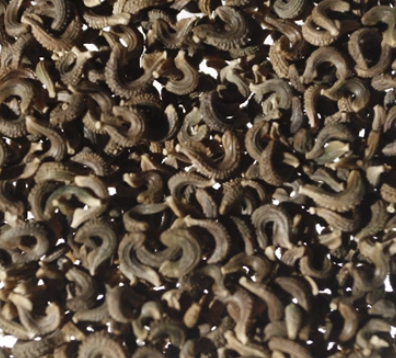Check the ingredients!
... live healthy!


| "Descrizione" by admin (19362 pt) | 2024-Sep-07 11:53 |
Calendula officinalis, commonly known as pot marigold, is a flowering plant widely recognized for its vibrant orange or yellow blooms. It is cultivated for its ornamental value as well as its medicinal and cosmetic properties. The plant is appreciated for its anti-inflammatory, antimicrobial, and soothing effects.
Botanical Classification:
Plant Characteristics:
Growth Form:Calendula officinalis is an annual herb that grows to a height of 30-60 cm (12-24 inches). It has a bushy, upright habit with branching stems.
Leaves: The leaves are lance-shaped to oval, with a green to gray-green color. They are covered with fine hairs, giving them a slightly fuzzy texture.
Flowers: The plant produces bright orange or yellow flower heads that are 5-7 cm (2-3 inches) in diameter. The flowers are composed of a central disc surrounded by ray florets, creating a daisy-like appearance. The flowers have a subtle, pleasant fragrance.
Chemical Composition and Structure:
Flavonoids: Calendula contains several flavonoids, including quercetin and kaempferol, which contribute to its antioxidant and anti-inflammatory properties.
Carotenoids: The flowers are rich in carotenoids such as lutein and beta-carotene, which have antioxidant effects and contribute to the plant's vibrant color.
Saponins: Saponins present in Calendula have antimicrobial properties and are believed to contribute to the plant's healing effects.
Essential Oils: The plant contains essential oils with components like calendulene and bisabolol, which are known for their soothing and anti-inflammatory properties.
How to Cultivate It:
Uses and Benefits:
Applications:
INCI Functions:
Fragrance. It plays a very important role in the formulation of cosmetic products as it provides the possibility of enhancing, masking or adding fragrance to the final product, increasing its marketability. It is able to create a perceptible pleasant odour, masking a bad smell. The consumer always expects to find a pleasant or distinctive scent in a cosmetic product.
Skin conditioning agent. It is the mainstay of topical skin treatment as it has the function of restoring, increasing or improving skin tolerance to external factors, including melanocyte tolerance. The most important function of the conditioning agent is to prevent skin dehydration, but the subject is rather complex and involves emollients and humectants that can be added in the formulation.
Perfuming. Unlike fragrance, which can also contain slightly less pleasant or characteristic odours, the term perfume indicates only very pleasant fragrances. Used for perfumes and aromatic raw materials.
Environmental and Safety Considerations:
Some of the most interesting studies on the properties of Calendula:

The content of Calendula officinalis has interesting components: phenolic complexes such as flavonoids and, to a lesser extent, ethanol. These components have a demonstrated antioxidant activity (1) also for the presence of terpenes, in particular pentacyclic triterperpenes, Taraxasterol, Lupeol, alpha-amirin, beta-amirin (2), kaempferol and narcissine (3) an alkaloid also found in narcissus.
Due to components such as rutin and quercetin, Calendula extract has shown a potential role in the healing of ulcers in the diabetic foot (3) and in wound healing (4).

A phytochemical analysis on the composition of Calendula seeds showed that 28-O-β-D-glucopyranosyl-oleanolic acid 3-O-β-D-glucopyranosyl (1→3)-β-D-glucopyranosiduronic acid has, in adults, a powerful stimulant effect for the production of hyaluronic acid on normal human dermal fibroblasts, while another acid, oleanolic acid 3-O-β-D-glucopyranosyl (1→3)-β-D-glucopyranosiduronic acid, showed a stimulating activity of melanin biosynthesis (5).

Due to its numerous polyphenolic antioxidants, Calendula has been evaluated both in the laboratory and in clinical settings for use in the treatment and prevention of radiotherapy skin reactions with conflicting results (6).
An interesting application of Calendula concerns the sterilizing properties of its extract (7).
References_____________________________________________________
(1) García-Risco MR, Mouhid L, Salas-Pérez L, López-Padilla A, Santoyo S, Jaime L, Ramírez de Molina A, Reglero G, Fornari T. Biological Activities of Asteraceae (Achillea millefolium and Calendula officinalis) and Lamiaceae (Melissa officinalis and Origanum majorana) Plant Extracts. Plant Foods Hum Nutr. 2017 Mar;72(1):96-102. doi: 10.1007/s11130-016-0596-8.
Abstract. Asteraceae (Achillea millefolium and Calendula officinalis) and Lamiaceae (Melissa officinalis and Origanum majorana) extracts were obtained by applying two sequential extraction processes: supercritical fluid extraction with carbon dioxide, followed by ultrasonic assisted extraction using green solvents (ethanol and ethanol:water 50:50). The extracts were analyzed in terms of the total content of phenolic compounds and the content of flavonoids; the volatile oil composition of supercritical extracts was analyzed by gas chromatography and the antioxidant capacity and cell toxicity was determined. Lamiaceae plant extracts presented higher content of phenolics (and flavonoids) than Asteraceae extracts. Regardless of the species studied, the supercritical extracts presented the lowest antioxidant activity and the ethanol:water extracts offered the largest, following the order Origanum majorana > Melissa officinalis ≈ Achillea millefolium > Calendula officinalis. However, concerning the effect on cell toxicity, Asteraceae (especially Achillea millefolium) supercritical extracts were significantly more efficient despite being the less active as an antioxidant agent. These results indicate that the effect on cell viability is not related to the antioxidant activity of the extracts.
(2) Martin D, Navarro Del Hierro J, Villanueva Bermejo D, Fernández-Ruiz R, Fornari T, Reglero G. Bioaccessibility and Antioxidant Activity of Calendula officinalis Supercritical Extract as Affected by in Vitro Codigestion with Olive Oil. J Agric Food Chem. 2016 Nov 23;64(46):8828-8837. doi: 10.1021/acs.jafc.6b04313.
Abstract. Supercritical extracts of marigold (ME) were produced and characterized. The bioaccessibility of terpenes, especially that of pentacyclic triterpenes (PT), the particle-size distribution, and antioxidant activity after the in vitro codigestion of ME with olive oil (OO) were determined. ME produced without cosolvent was richer in taraxasterol, lupeol, α-amyrin, and β-amyrin than extracts with cosolvent. All terpenes showed high bioaccessibility without OO (>75%). Significant correlations were found between the molecular properties of compounds (logP and number of rotatable bonds) and their bioaccessibility. Codigestion with OO enhanced the bioaccessibility (around 100% for PT), which could be related to a higher abundance of low-size particles of the digestion medium. The antioxidant activity of the digested ME increased around 50%, regardless of OO. PT-rich extracts from marigold display high bioaccessibility and improved antioxidant activity after in vitro digestion, although complete bioaccessibility of PT can be reached by codigestion with oil, without affecting antioxidant activity.
(3) Buzzi M, de Freitas F, Winter M. A Prospective, Descriptive Study to Assess the Clinical Benefits of Using Calendula officinalis Hydroglycolic Extract for the Topical Treatment of Diabetic Foot Ulcers. Ostomy Wound Manage. 2016 Mar;62(3):8-24. PMID: 26978856..
Abstract. Diabetic foot ulcers (DFUs) have a significant impact on patient quality of life. A prospective, descriptive pilot study was conducted between May 2012 and December 2013 through the dermatology outpatient unit in a Brazilian hospital to evaluate the clinical benefits of using Calendula officinalis hydroglycolic extract in the treatment of DFUs. Patients diagnosed with a stable neuropathic ulcer of >3 months' duration; ranging in size from 0.5-40 cm(2); without osteomyelitis, gangrene, bone exposure, cancer, or deep tissue infection; ages 18-90 years; with adequate glycemic control and no history of an allergy to C. officinalis were enrolled. Patients provided demographic and diabetes-related information and were evaluated biweekly for 30 weeks or until healing (ie, full epithelialization with no wound drainage). DFUs were measured and clinically examined for microbiological flora and presence of odor, tissue type (eg, granulation, fibrin sloth, necrosis), exudate, and retraction rate using planimetry images. Patients' blood tests and neuropathic pain assessment (the latter by clinician-directed questionnaire) were performed at baseline and the end of treatment; pain also was assessed during dressing changes using a 10-point rating scale. Patients' ulcers were treated twice daily with C. officinalis hydroglycolic extract spray solution and covered with saline-moistened, sterile, nonadherent gauze and bandages followed by foot offloading with adequate protective footwear. Patients received their first treatment in the clinic then performed care at home. From a potential population of 109 patients, 25 did not meet the inclusion criteria. Of the remaining 84 participants enrolled, 43 withdrew before study completion; cited reasons included lost to follow-up (16), medical judgment (2), failure to attend >3 scheduled visits (17), protocol violation (5), and death (3). Forty-one (41) - 17 women, average age 62 years (range 44-82 years), average glycemic level 153 mg/dL (range 82-395 mg/dL), most (34) with Wagner type 1 ulcers--completed the study. The proportions of patients who achieved complete wound closure after 11, 20, and 30 weeks of treatment was 54%, 68%, and 78%, respectively; mean healing time was 15.5 ± 6.7 weeks. When individual weekly healing rates (the percentage reduction in wound area per week) were corrected for variability in initial DFU area, the values were nearly 6-fold higher for complete wound closure (7.8% ± 3.6%) than for incomplete wound closure (1.4% ± 0.7%) (Student t-test; P = 0.001). After 30 weeks of treatment, the number of colonized wounds decreased from 29 at baseline to 5, and the number of odorous wounds decreased from 19 to 1. Ulcer bed planimetry data showed a significant reduction in the amount of exudate, fibrin slough, and necrotic tissue after the treatment with C. officinalis hydroglycolic extract (χ(2) test; P = 0.001). No adverse events were observed during treatment. The study findings suggest C. officinalis extract is safe and has a beneficial effect on DFU healing. Randomized, controlled studies using C. officinalis hydroglycolic extract are warranted to confirm its safety and establish its clinical efficacy and effectiveness for the topical treatment of DFUs.
(4) Dinda M, Mazumdar S, Das S, Ganguly D, Dasgupta UB, Dutta A, Jana K, Karmakar P. The Water Fraction of Calendula officinalis Hydroethanol Extract Stimulates In Vitro and In Vivo Proliferation of Dermal Fibroblasts in Wound Healing. Phytother Res. 2016 Oct;30(10):1696-1707. doi: 10.1002/ptr.5678.
(5) Zaki A, Ashour A, Mira A, Kishikawa A, Nakagawa T, Zhu Q, Shimizu K. Biological Activities of Oleanolic Acid Derivatives from Calendula officinalis Seeds. Phytother Res. 2016 May;30(5):835-41. doi: 10.1002/ptr.5589.
(6) Kodiyan J, Amber KT. A Review of the Use of Topical Calendula in the Prevention and Treatment of Radiotherapy-Induced Skin Reactions. Antioxidants (Basel). 2015 Apr 23;4(2):293-303. doi: 10.3390/antiox4020293.
Abstract. Calendula is a topical agent derived from a plant of the marigold family Calendula Officinalis. Containing numerous polyphenolic antioxidants, calendula has been studied in both the laboratory and clinical setting for the use in treating and preventing radiation induced skin toxicity. Despite strong evidence in the laboratory supporting calendula's mechanism of action in preventing radiation induced skin toxicity, clinical studies have demonstrated mixed results. In light of the controversy surrounding the efficacy of calendula in treating and preventing radiodermatitis, the topic warrants further discussion.
(7) Goktas FM, Sahin B, Yigitarslan S. Production of Sterilizing Agents from Calendula officinalis Extracts Optimized by Response Surface Methodology. Int J Anal Chem. 2015;2015:789732. doi: 10.1155/2015/789732. Epub 2015 May 7. PMID: 26064122;
Abstract. The aim of this study was to produce hand sterilizing liquid and wet wipes with the extracts of Calendula officinalis. Since this plant has well known antimicrobial activity due to its phytochemical constituents, the increase in the extraction yield was chosen as the principle part of the production process. To achieve the maximum yield, parameters of solid-to-liquid ratio, extraction temperature, and time were studied. The optimum conditions were determined by response surface methodology as 41°C, 7 h, and 3.3 g/200 mL for temperature, time, and solid-to-liquid ratio, respectively. The yield achieved at those conditions was found to be 90 percent. The highest amounts of flavonoids were detected at optimum, whereas the highest triterpene and saponin constituents were determined at different design points. The microbial efficiencies of extracts were determined by the inhibition of the growth of selected microorganisms. Different dilution rates and interaction times were used as parameters of inhibition. Not any of the constituent but symbiotic relation in-between reached the highest inhibition of 90 percent. The pH values of the extracts were 5.1 to 5.4. As a result, the extraction of Calendula officinalis at the optimum conditions can be used effectively in the production of wet wipes and hand sterilizing liquid.
| Evaluate |